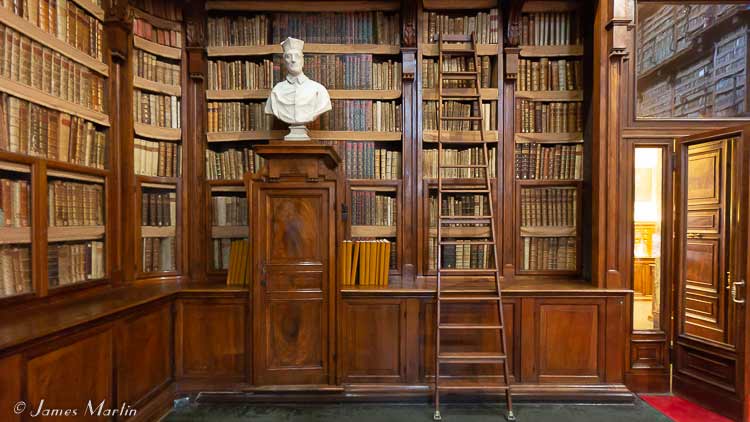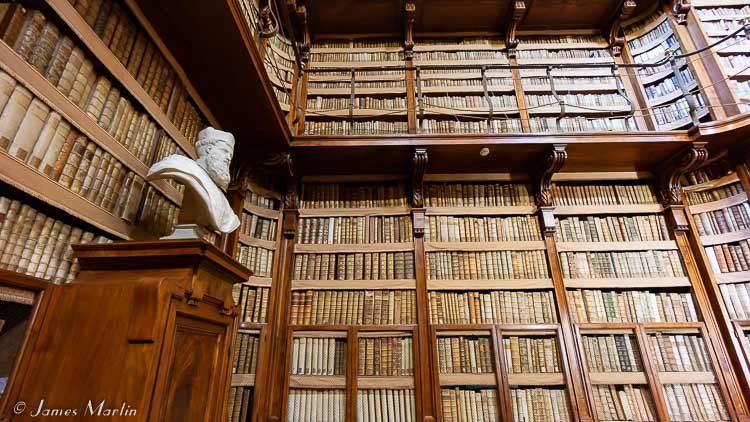The money a society devotes to shared public resources was once a sign of its greatness. Reading—gaining sense through knowing the past through the writing from the humanity’s greatest minds—was a big deal long ago. We can gain a sense of what used to be considered greatness by visiting some of Rome’s historic libraries.

In raucous Rome, libraries also represent a sanctuary from the happy disorder of the streets. The quiet wraps you like a blanket, the filtered light bathes you. The books and statues are carefully placed to look down upon you kindly.
In the center of Rome, the place where you’re likely to have planned your holiday’s boundaries, there are three libraries we think are well worth a look. They are historic, but they are still in use by scholars eager to chart the past to relate it to the present—so tread lightly. A visit by a gawking tourist is a privilege, not a right. There are times you won’t be able to see much, due to events and crowding. Shrug it off; visit another time.
Notice the opulence in these pictures. Notice the attention to the details of creating a scholarly environment with expensive materials. It all is there to remind us how knowledge, passed on by people who dedicated themselves to using their brains, was highly regarded during these times.
Biblioteca Angelica
This was the first historic library of Rome we visited. We didn’t make guided tour arrangements in advance, so we were led into a single room that was accessible to outsiders. We could peruse the floor to ceiling books, take pictures, and admire the statues. A guided tour for groups opens more of the library to visitors, see the official site below for booking information.

The Biblioteca Angelica owes its name to the Augustinian Bishop Angelo Rocca (1546-1620), an erudite writer and a keen collector of rare editions. He was in charge of the Vatican Printing House during the pontificate of Pope Sixtus V.
Bishop Angelo Rocca entrusted his collection of some 20,000 volumes to the friars at the convent of St. Augustine in Rome at the end of the sixteenth century.
Over the previous centuries the Augustinian collection had acquired valuable manuscripts donated by Roman nobles, and codices transcribed by or belonging to the friars themselves who left them to the monastery when they died. Angelo Rocca provided the new library with a suitable building, an annuity and a set of regulations. He wished the library to be open to everyone irregardless of their income or social standing. The novelty of this institution gave rise to an ever-increasing interest by the general public and soon the library’s fame spread to scholars all over the world. — Biblioteca Angelica – Official Site
Location map: The Angelica Library, Piazza di Sant’Agostino, 8, Rome, Italy
Official Website with opening times, history, and guided tour information.
Casatenense Library (Biblioteca Casanatense)

The Casanatense Library was founded by the Dominicans of the Monastery of Santa Maria sopra Minerva in Rome and opened to the general public, according to the will of Cardinal Girolamo Casanate.
In order to contain the Library’s collection the Friars built a new architectural structure in the area of the monastery’s cloister. The Salone (hall) was probably designed by the well-known Roman architect Carlo Fontana, but it was finally realized by Antonio Maria Borioni. The Library was opened on November 3, 1701, only one year after cardinal Casanate’s death. The first nucleum of the Library was the Cardinal’s collection, which contained up to 25.000 volumes. — Biblioteca Casanatense History
The Library’s collection contains about 400.000 volumes, as well as a couple of historic globes from 1716 by Silvestro Amanzio Moroncelli, statues, and scientific instruments.
And they are provocative globes. How fun study must have been in the 1700s!

Biblioteca Casanatense location map | Official Page
The Valcelliana Library
Not far from the Piazza Navona is the Biblioteca Vallicelliana near the church called Parrocchia Santa Maria in Vallicella. The church has lots of art to see inside, and you can walk up to the dome for an awesome view of Rome.
This hidden gem was designed by Borromini, and much of the furniture was designed by the artist.

There are more than 130,000 volumes to be found here, and the library has expanded its collection since Filippi Neri founded the library in 1565.
The library is open Monday to Friday and every other Saturday and is free to visit.

Biblioteca Vallicelliana location map | Facebook page
Enjoy a visit to these historic libraries.
What’s Next?
A visit to the Appian Way perhaps?
Further afield: Biblioteca Malatestiana: A Treasure in Cesena which sports a wooden interior door from 1457 and a library of miniature books.
Italy Travel Essentials
Our Favorite European Plug Adapter for Italy